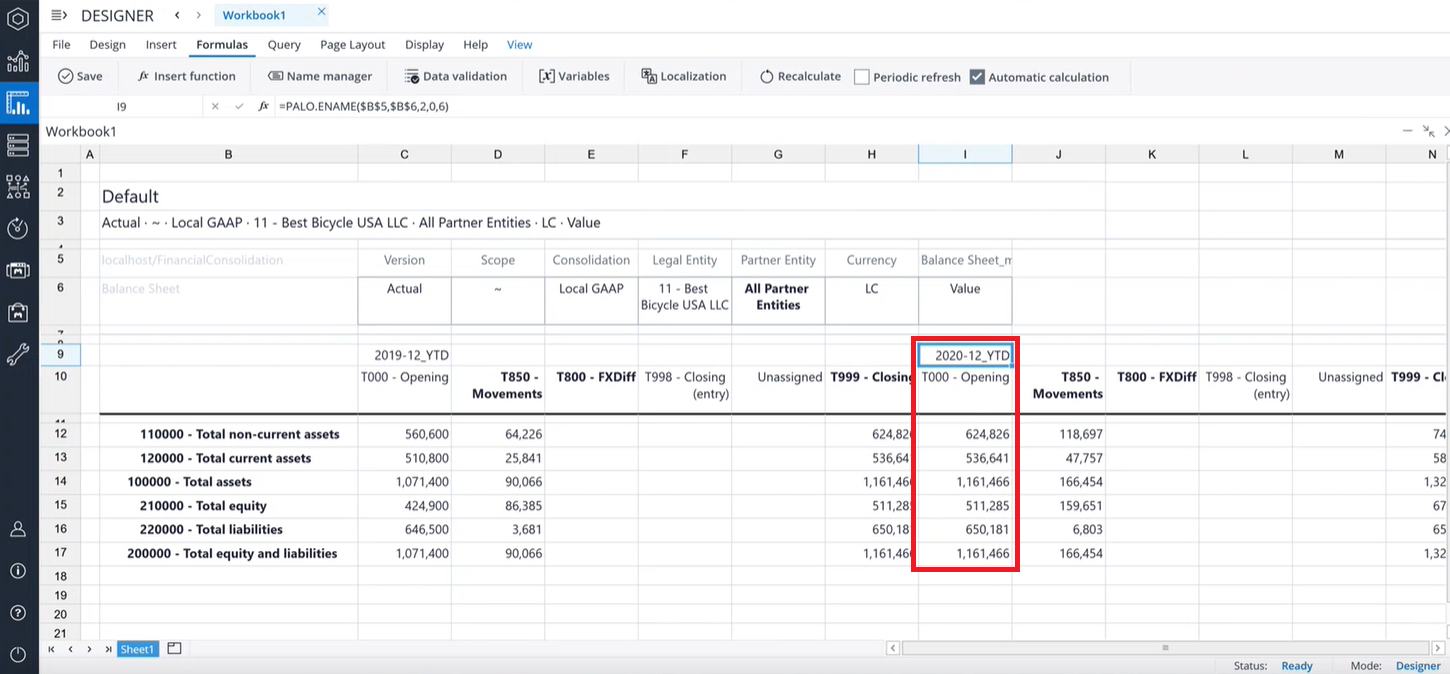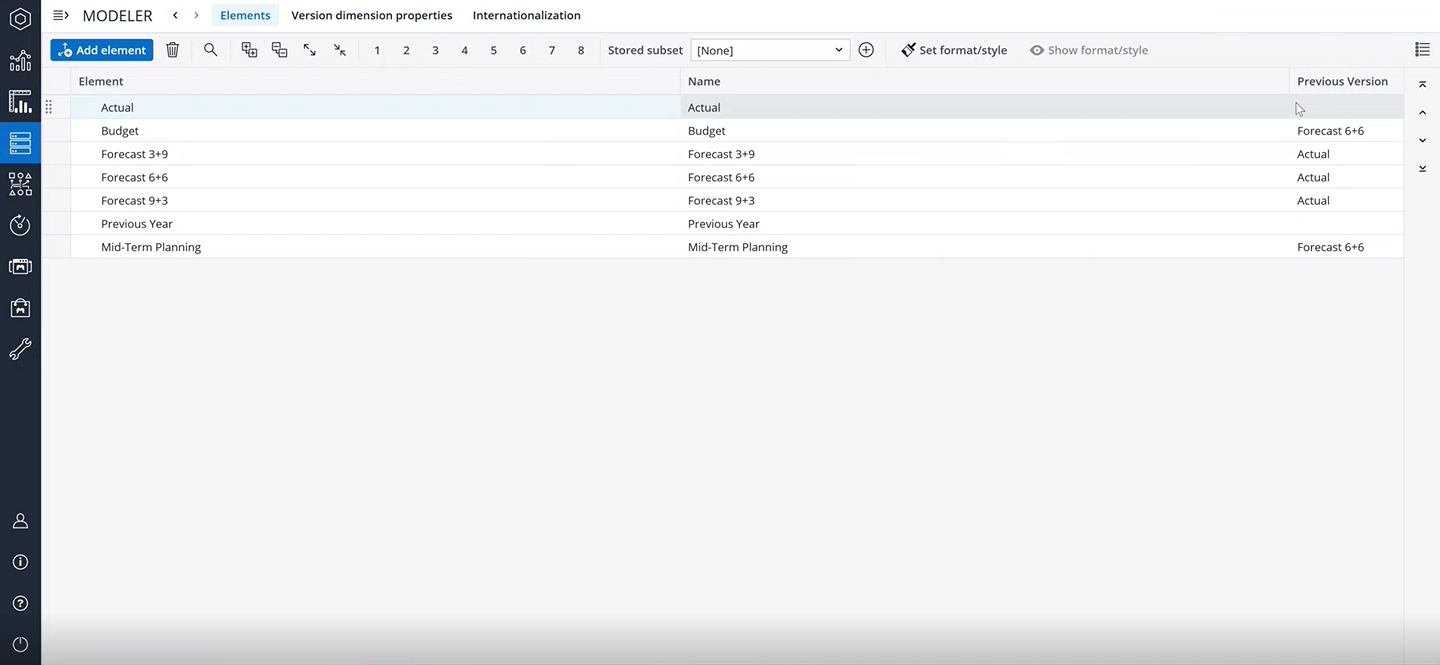Return to Financial Consolidation model Overview
In any finance application with a balance sheet statement, the opening value must reconcile with the previous (prior) period's closing value. While it is possible to manually collect the opening balances along with the other data, this process could be error-prone. Therefore, it is recommended to always use the Bring Balances Forward procedure. The Bring Balances Forward tool helps you populate the opening balance with the closing balance of the prior planning or reporting period.
Note that if you are using a Jedox model for for the very first reporting period, you cannot use the Bring Balances Forward option as there is no data to bring forward. In this case, you have to import the opening balances directly to the cubes.
You can run the Bring Balances Forward through its button in Data Management. For more information see the Data Manager Report (Financial Consolidation) article.
Technical perspective
Bring Balances Forward runs as a batch job on the database, copying the data from the Balance Sheet and Balance Sheet (Segment) cubes. It then uses the copied data to populate the opening balance. Bring Balances Forward works on all four hierarchies, i.e., T999 (Closing), T992 (Gross carrying amount, Closing), T993 (Accumulated depreciation and amortisation, Closing), T994 (Accumulated impairment, Closing).
When you execute the Bring Balances Forward tool the following process happens in the background.
Note that “the closing balance of the previous reporting period” below means the closing balance of the period you chose your data to be copied from, and “the opening balance of the current reporting period” means the period you want to paste the copied data into.
As the first step, Bring Balances Forward removes the previously stored data, if any, from the opening transaction types T000, T002, T003, and T004.
Once the previously stored data is deleted, the Bring Balances Forward copies the LC (Local Currency) amounts from "the closing balance of the previous reporting period", and pastes them into "the opening balance of the current reporting period" using the following mapping.
Month_YTD dimension: on the Month_YTD dimension, the Bring Balances Forward copies the data from the PriorPeriod attribute as "the closing balance of the previous reporting period". The copied data is then pasted into the opening transaction type of the current Month_YTD.
Version dimension: on the Version dimension the Bring Balances Forward copies the data from the Previous Version attribute of "the closing balance of the previous reporting period". The copied data is then pasted into "the opening balance of the current reporting period's" Version.
Note that the Actual Version does not have any data in the Previous Version attribute as the Bring Balances Forward uses the previous period’s Actual as "the closing balance of the previous reporting period". However, in the Planning Versions, there is a certain set of mappings. The reason for this is that when you are, for example, planning the next year’s Budget, the previous period’s Budget might not be reliable, or up to date. Therefore, Forecast 6+6 which is the most reliable figure in this scenario is used as the Previous Version for the Budget Version.
Transaction Type dimension: on the Transaction Type dimension, the Bring Balances Forward executes multiple hierarchies simultaneously.
It copies the data from
T999 (Closing)as its source, and pastes it into theT000 (Opening Balance).It copies the data from
T992 (Gross carrying amount, closing)as its source and pastes it into theT002 (Gross carrying amount, opening).It copies the data from
T993 (Accumulated depreciation and amortisation)as its source and pastes it into theT003 (Accumulated depreciation and amortisation, opening).It copies the data from
T994 (Accumulated impairment, closing)as its source and pastes it into theT004 (Accumulated impairment, opening).Also, it copies anything that is configured in the Bring Balances Forward and pastes it into the
Transaction Typeattribute of theTransaction Type dimension.
BS Account dimension or BS Account (Segment) dimension: in these dimensions, for all balance sheet accounts which have an empty Bring Balances Forward to Account attribute, the Bring Balances Forward uses the same account as both the source and destination. For all balance sheet accounts which have a non-empty Bring Balances Forward to Account attribute (e.g., 211200 (Retained earnings, profit (loss) for reporting period)), the Bring Balances Forward copies the data from the original balance sheet account and pastes it into the balance sheet account from the Bring Balances Forward to Account attribute (e.g., 211201 (Retained earnings, profit (loss) excluding for reporting period)).
Historic conversion type and target currencies: for all balance sheet accounts using the Historic conversion type and for all target currencies (e.g., USD) the Bring Balances Forward use the above mapping plus one additional mapping. For the Currency dimension, the Bring Balances Forward copies the amount converted into the target currency (e.g. > USD), and pastes it into the corresponding historic currency element (e.g. USD_Historic).
Implementation
The Bring Balances Forward is implemented as integrator job xdac30_40_Bring balances forward in the Data Management project
Updated July 3, 2025

